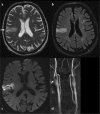Carotid embolectomy and endarterectomy for symptomatic complete occlusion of the carotid artery as a rescue therapy in acute ischemic stroke
- PMID: 22220158
- PMCID: PMC3250650
- DOI: 10.1159/000335069
Carotid embolectomy and endarterectomy for symptomatic complete occlusion of the carotid artery as a rescue therapy in acute ischemic stroke
Abstract
Emergency endarterectomy of an occluded internal carotid artery (ICA) has not been investigated as an option of rescue therapy for severe acute ischemic stroke in the era of intravenous (IV) thrombolysis treatment neither as a primary treatment nor after failed IV thrombolysis. Data from the pre-IV thrombolysis era are conflicting and therefore emergency endarterectomy has not been recommended. The number of patients reaching the emergency room within the IV thrombolysis time window has vastly grown due to advanced acute stroke treatment protocols. The efficacy of mechanical thrombectomy as a primary or add-on to IV thrombolysis therapy option is being actively investigated. We herein report 2 cases of acute ischemic stroke with computerized tomography (CT) angiography-documented occlusion of an ICA that were treated with emergency carotid endarterectomy and embolectomy to restore cerebral blood flow. Both cases presented with severe stroke symptoms and signs not responding to IV thrombolysis and showed severe CT-perfusion deficits mainly representing ischemic penumbra. Blood flow was surgically restored after 5 h of symptom onset. Both patients achieved a favorable outcome. We conclude that timely surgical approach of acute ICA occlusion after failed thrombolysis as a rescue therapy may be a viable option in well-selected patients.
Keywords: Acute stroke treatment; Carotid endarterectomy; Embolectomy; Internal carotid artery.
Figures




Similar articles
-
Emergent intracranial surgical embolectomy in conjunction with carotid endarterectomy for acute internal carotid artery terminus embolic occlusion and tandem occlusion of the cervical carotid artery due to plaque rupture.J Neurosurg. 2015 Apr;122(4):939-47. doi: 10.3171/2014.11.JNS132855. Epub 2015 Jan 9. J Neurosurg. 2015. PMID: 25574571
-
Emergent Carotid Thromboendarterectomy for Acute Symptomatic Occlusion of the Extracranial Internal Carotid Artery.Vasc Endovascular Surg. 2017 May;51(4):176-182. doi: 10.1177/1538574416674641. Epub 2017 Mar 20. Vasc Endovascular Surg. 2017. PMID: 28424044
-
Combined interventional and surgical treatment of tandem middle cerebral artery embolus and internal carotid artery occlusion: case report.J Neurosurg. 2018 Sep;129(3):718-722. doi: 10.3171/2017.6.JNS162368. Epub 2017 Nov 17. J Neurosurg. 2018. PMID: 29148900
-
Intravenous thrombolysis and endovascular therapy for acute ischemic stroke with internal carotid artery occlusion: a systematic review of clinical outcomes.Stroke. 2012 Sep;43(9):2362-8. doi: 10.1161/STROKEAHA.112.655621. Epub 2012 Jul 17. Stroke. 2012. PMID: 22811456
-
Extension of therapeutic window in ischemic stroke by selective mismatch imaging.Int J Stroke. 2019 Jun;14(4):351-358. doi: 10.1177/1747493019840936. Epub 2019 Apr 1. Int J Stroke. 2019. PMID: 30935350 Review.
Cited by
-
Complex interventional treatment in a patient with atrial fibrillation and stroke caused by large carotid artery thrombus: a case report.BMC Neurol. 2015 Apr 24;15:62. doi: 10.1186/s12883-015-0322-4. BMC Neurol. 2015. PMID: 25902793 Free PMC article.
-
Acute Hemispheric Stroke: Full Remission Following Surgical Thrombectomy.EJVES Vasc Forum. 2020 Apr 8;47:31-34. doi: 10.1016/j.ejvsvf.2020.03.002. eCollection 2020. EJVES Vasc Forum. 2020. PMID: 33937891 Free PMC article.
References
-
- Hacke W, Kaste M, Bluhmki E, et al. Thrombolysis with alteplase 3 to 4.5 h after acute ischemic stroke. N Engl J Med. 2008;359:1317–1329. - PubMed
-
- Capoccia L, Sbarigia E, Speziale F, Toni D, Fiorani P. Urgent carotid endarterectomy to prevent recurrence and improve neurologic outcome in mild-to-moderate acute neurologic events. J Vasc Surg. 2011;53:622–627. - PubMed
-
- Dorigo W, Pulli R, Nesi M, et al. Urgent carotid endarterectomy in patients with recent/crescendo transient ischaemic attacks or acute stroke. Eur J Vasc Endovasc Surg. 2011;41:351–357. - PubMed
Publication types
LinkOut - more resources
Full Text Sources
Miscellaneous

